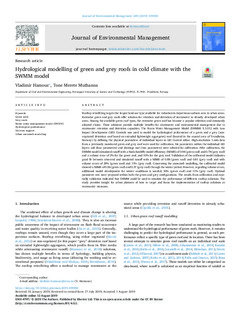| dc.contributor.author | Hamouz, Vladimir | |
| dc.contributor.author | Muthanna, Tone Merete | |
| dc.date.accessioned | 2019-10-04T11:30:30Z | |
| dc.date.available | 2019-10-04T11:30:30Z | |
| dc.date.created | 2019-09-30T09:09:32Z | |
| dc.date.issued | 2019 | |
| dc.identifier.issn | 0301-4797 | |
| dc.identifier.uri | http://hdl.handle.net/11250/2620321 | |
| dc.description.abstract | Rooftop retrofitting targets the largest land-use type available for reduction in impervious surfaces area in urban areas. Extensive green and grey roofs offer solution for retention and detention of stormwater in densely developed urban areas. Among the available green roof types, the extensive green roof has become a popular selection and commonly adopted choice. These solutions provide multiple benefits for stormwater and environmental management due to stormwater retention and detention capacities. The Storm Water Management Model (SWMM) 5.1.012 with Low Impact Development (LID) Controls was used to model the hydrological performance of a green and a grey (non-vegetated detention roof based on extruded lightweight aggregates) roof (located in the coastal area of Trondheim, Norway) by defining the physical parameters of individual layers in LID Control editor. High-resolution 1-min data from a previously monitored green and grey roof were used for calibration. Six parameters within the individual LID layers: soil (four parameters) and drainage mat (two parameters) were selected for calibration. After calibration, the SWMM model simulated runoff with a Nash-Sutcliffe model efficiency (NSME) of 0.94 (green roof) and 0.78 (grey roof) and a volume error of 3% for the green roof, and 10% for the grey roof. Validation of the calibrated model indicates good fit between observed and simulated runoff with a NSME of 0.88 (green roof) and 0.81 (grey roof) and with volume errors of 29% (green roof) and 11% (grey roof). Concerning the snowmelt modelling, the calibrated model showed a NSME of 0.56 (green roof) and 0.37 (grey roof) through the winter period. However, regarding volume errors, additional model development for winter conditions is needed; 30% (green roof) and 11% (grey roof). Optimal parameter sets were proposed within both the green and grey configurations. The results from calibration and especially validation indicated that SWMM could be used to simulate the performance of different rooftop solutions. The study provides insight for urban planners of how to target and focus the implementation of rooftop solutions as stormwater measures. | nb_NO |
| dc.language.iso | eng | nb_NO |
| dc.publisher | Elsevier | nb_NO |
| dc.rights | Navngivelse 4.0 Internasjonal | * |
| dc.rights.uri | http://creativecommons.org/licenses/by/4.0/deed.no | * |
| dc.title | Hydrological modelling of green and grey roofs in cold climate with the SWMM model | nb_NO |
| dc.type | Journal article | nb_NO |
| dc.type | Peer reviewed | nb_NO |
| dc.description.version | publishedVersion | nb_NO |
| dc.source.volume | 249 | nb_NO |
| dc.source.journal | Journal of Environmental Management | nb_NO |
| dc.identifier.doi | 10.1016/j.jenvman.2019.109350 | |
| dc.identifier.cristin | 1731005 | |
| dc.relation.project | Norges forskningsråd: 237859 | nb_NO |
| dc.description.localcode | © 2019 The Authors. Published by Elsevier Ltd. This is an open access article under the CC BY license (http://creativecommons.org/licenses/BY/4.0/). | nb_NO |
| cristin.unitcode | 194,64,91,0 | |
| cristin.unitname | Institutt for bygg- og miljøteknikk | |
| cristin.ispublished | true | |
| cristin.fulltext | postprint | |
| cristin.qualitycode | 1 | |

